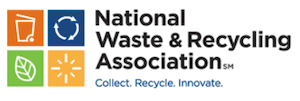
Automated Pickup
NWRA POSITION
Automated pickup of waste and recycling containers by collection vehicles should be encouraged where it is logistically and economically feasible.
BACKGROUND
NWRA recognizes that the safest place for its members’ employees is in their truck cabs and not out on the streets. As automation is more deeply integrated into our daily lives, we believe that technologies can be employed to improve the safety of the men and women in the waste and recycling industry.
Automated pickup where a hydraulic arm is operated from within the vehicle to empty standardized containers into a waste or recycling collection truck has the benefits of being safer and more sanitary than traditional collection. Employees do not need to exit the vehicle or lift heavy containers, but instead use an automated claw attached to the end of the arm to grasp, pickup, and empty the carts.
Increased route productivity and decreased injury rates that translate into a reduction in workers’ compensation claims are prime benefits of using automated collection technology for residential pickup. The biggest challenges to automated pickup include additional vehicle maintenance for the hydraulic arm collection equipment, accommodating bulk waste, and locations that do not possess the requisite space to operate the equipment.
Thousands of American cities have implemented forms of automated pickup over the past decade. Policies and incentives encouraging further adoption of automated pickup where it is logistically and economically feasible should be supported.
TALKING POINTS
- Automated pickup increases the safety of waste and recycling industry employees by removing them from roadside dangers and situations that can lead to injuries.
- This process can increase the productivity and hygiene of the waste and recycling collection system.
- While automated pickup may not be feasible from an economic or logistical standpoint in every instance, there remains significant potential for further adoption which should be encouraged through incentives and public policy.
Updated January 2019.

